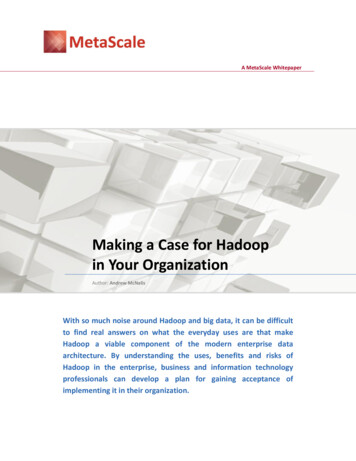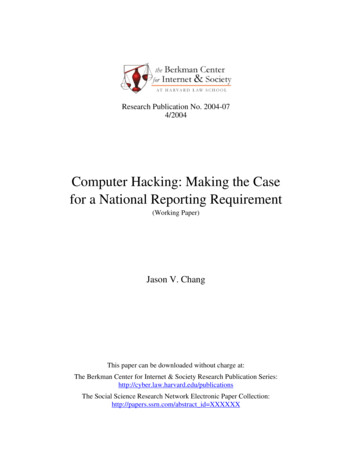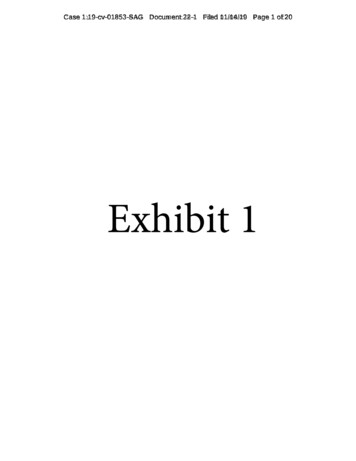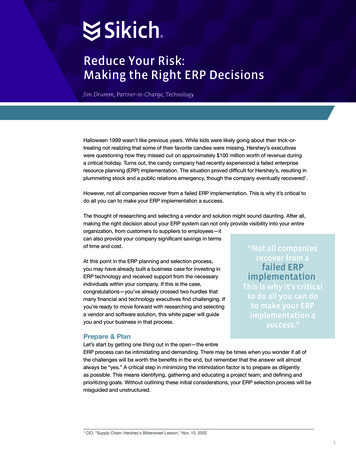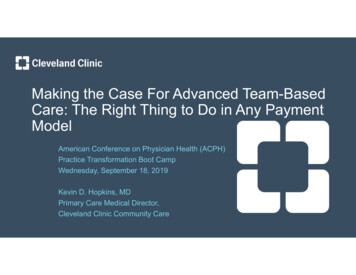
Transcription
Making the Case For Advanced Team-BasedCare: The Right Thing to Do in Any PaymentModelAmerican Conference on Physician Health (ACPH)Practice Transformation Boot CampWednesday, September 18, 2019Kevin D. Hopkins, MDPrimary Care Medical Director,Cleveland Clinic Community Care
The Cleveland Clinic in 2019 66,000 Caregivers4,200 Physicians295,000 Hospital Admissions245,000 Surgical Cases7.9 Million Annual Outpatient Visits1,923 Residents & Fellows18 Hospitals210 Outpatient locations18 Family Health Centers27 Institutes, 140 Specialties
2018-’19 HIGHLIGHTS #2 in the world, Newsweek, 2019#2 in the nation, US News and World Report in 2018#4 in the nation, US News and World Report in 2019#1 in the US for cardiac care since 1995Magnet recognition and Pathway to Excellence designationfor nursing
Cleveland Clinic Locations
Regional HospitalEUCLID HOSPITALFamily Health CenterHealth & Wellness CenterAVON HOSPITALAVON LAKEAMHERSTLORAINLAKEWOODAVON POINTE RICHARD E. JACOBSHEALTH CENTER, AVON NICLUTHERANHOSPITALWILLOUGHBY HILLSSTEPHANIE TUBBS JONESHEALTH CENTERHILLCREST HOSPITALBEACHWOODSOUTH POINTE HOSPITALCHAGRIN RONGSVILLEBRUNSWICKMEDINA HOSPITALMONTROSESTOWAKRON GENERALMEDICAL CENTERLODI HOSPITALWOOSTERGREEN
Cleveland Clinic Community Care (4C)People-1,600 caregivers: 564 staff and 216 APPs-168 residents: 9% of total GMECare-30% of total discharges (employed)-1.55 million annual visits: 35% of E M volume of CCFEconomics-750k empaneled patients by the end of 2019-Average 2k downstream revenue per patient/year
What Is Burnout?“A stress reaction marked bydepersonalization, emotional exhaustion, afeeling of decreased personal achievementand a lack of empathy for patients”-AMA Definition
Burnout“We feel caught between doing the work ourpatients need and the work we feel ismandatory in our environment. When thosecompeting demands are not aligned, itcreates a situation that is simplyunmanageable for many physicians and otherhealth professionals.”- Christine Sinsky, MD, Internist,VP of Professional Satisfaction, AMA
Manifestations of Burnout Exhaustion Depersonalization/Cynicism Reduced effectiveness
BurnoutPhysicians 54%Population 28%2011201220132014
Burnout51%43%FemaleMale
Which specialty has the highestburnout rate?A. Hematology/OncologyB. Family MedicineC. PediatricsD. Emergency MedicineE. Dermatology
72% ad6363PM&RFM64UroER
Satisfaction With Work-Life Balance6355494120112014PhysiciansGeneral Population
The Physician’s Foundation Only 31% of physicians identify as independent practice owners orpartners, down from 33% in 2016 and down from 48.5% in 2012.Employed physicians work more hours yet see fewer patients thanpractice owners.80% of physicians are at full capacity or are overextended.55% describe their morale as somewhat or very negative, a numberconsistent with findings in previous years.78% sometimes, often or always experience feelings of burnout.23% of physician time is spent on non-clinical paperwork.46% plan to change career paths-17% plan to retire (up from 14% in 2016) while12% plan to find a non-clinical job or position.
Medical Economics What’s ruining medicine for physicians?- 44%, Paperwork and administrative burdens What is the top challenge you face in yourpractice?- 79%, Administrative tasks Do you feel burned out?- 84% Yes, 16% No
OUCH!82% of physicians believe that executiveswithin their own organization don’t careenough to help
36%would NOTchoose medicineagain
Patient ImpactMedical errorsQuality & outcomesPatient satisfaction
Physician ImpactInterpersonal relationshipsSubstance abuseEarly retirement
Organizational ImpactProductivityEngagementTurnover
Cleveland Clinic Part-Time 16
BurnoutPhysicians 54%Population 28%2011201220132014
Why is Burnout More CommonAmong Physicians? The PersonThe PlaceThe ProfessionThe Paradigm
Causes of Burnout AmongHealthcare Workers
WorkOverloadWork Overload
Loss of Control
Loss of Autonomy & Prestige69% of physicians believe that their clinical autonomy is sometimesor often limited and their decisions may be compromised
Insufficient Reward
Community Breakdown
Absence of Fairness
Conflicting Values
So, Why Do We Need a Team?
How many hours per day are required for a physician to perform allrecommended preventative care, acute care, and chronic diseasemanagement for a primary care panel of 2,500 patients?A. 6 hoursB. 8.8 hoursC. 14.2 hoursD. 16.5 hoursE. 22.6 hours
The Time Problem A panel of 2,500 primary care patients- Chronic disease managementhrs/day- Preventative Carehrs/day- Acute Carehrs/dayTotal10.67.44.622.6 hrs/day
136 Millionemails in 2015
Patient Messages3.5Million2006 2007 2008 2009 2010 2011 2012 2013 2014 2015
Electronic OverloadMillions ofClicks165,000 cumentationEmailAlertFatigueTelemedicine
Healthcare gful UseValue-basedCareCost of l ClinicsPay for Performance
Knowledge ExplosionBiometricDataSuperComputing1,500 DrugsAlgorithms108,000 cal Trials
What is the projected rate at whichmedical knowledge is doubling?A. Every 10 yearsB. Every 3.5 yearsC. Every yearD. Every 73 daysE. Every other day
Healthcare Knowledge 1921-Doubling every 150 years1950-Doubling every 50 years1980-Doubling every 7 years2010-Doubling every 3.5 years2020-Doubling every 73 days
50% day EHR/desk 1 hr F2F: 2 hr EHR 1-2 hr EHR at night24%49%Direct F2F w/patient27%EHR/Deskwork
Work after Work:Evidence From PCP Utilization of an EHR SystemBrian Arndt, MD; John Beasley, MD; Jon Temte, MD PhD; Wen‐Jan Tuan, MS MPH; Valerie Gilchrist, MDUniversity of Wisconsin Department of Family Medicine and Community Health CategorySexResidency ClinicYears of PracticeTo assess usage patterns of PCPs interacting with an EHR systemduring and after work hours(“workhours” 8:00 am –6:00 pm Monday ‐ 6 0.90-1.00.70-0.890.50-0.690.30-0.49 0.30NoYesNote: Clinician statistics were based on UW Health’s December 2014 panel data. Retrospective cohort study from 1/1/13‐ 6/30/15System access logs were extracted to compute PCP time spenton various face‐to‐face and non‐face‐to‐face tasksA fuzzy matching model was used to restructure physicians’tasks into events, segments, and sessions in a hierarchicalmanner to depict each physician’s EHR interactions: 13129015% 111098 969.330.73,493,423Over # of SessionsTotal EHR Duration– Workhours and(%)DateTimeMetric TypeMetricIDMetric NameDescriptionPatient Name12/17/20149:05:10 CONNECTION EVENTS14010 Login12/17/20149:08:01 PATIENT CLINICAL INFO20620 AC VISIT NAVIGATOR12/17/20149:08:02 PATIENT CLINICAL INFO17133 MR VN CONTACTSVisit Navigator Contacts section initialized.AUTAUD,TEST12/17/20149:08:03 PATIENT CLINICAL INFO17124 MR CHIEF COMPLAINTVisit Navigator Chief Complaint section initializAUTAUD,TEST12/17/20149:08:03 PATIENT CLINICAL INFO17117 MR ENC SMARTSETSSmartsets activity selected for patient.AUTAUD,TEST12/17/20149:08:03 PATIENT CLINICAL INFO49008 FLOWSHEETVN Flowsheet section is accessed.AUTAUD,TEST12/17/20149:08:03 PATIENT CLINICAL INFO17104 MR ENC ENCOUNTERA Navigator for a patient encounter opened.AUTAUD,TEST12/17/20149:08:04 PATIENT CLINICAL INFO17106 MR MEDICATIONSMedications activity accessed.AUTAUD,TEST12/17/20149:08:15 PATIENT ORDERS17108 MR ENC ORDERSOrder Entry activity accessed.AUTAUD,TEST12/17/20149:08:40 PATIENT CLINICAL INFO17148 MR COMM MGTCommunication Management Section of the VisitAUTAUD,TESTAUTAUD,TESTSetting / Participants 130 family physicians (average experience 19.4 years) from 18clinics (4 residency, 14 community) managed by the Universityof Wisconsin Department of Family Medicine and CommunityHealth41%Of P H C O Or M M OfClLe15%fichooshaB de y ed f- initte21%14%25%21%11%31%18%36%e n p r v r C r s c r Wor 8 11109% 87654123117 - 7 D1 C Or C M Sy Pr C AdPh C Le CliBil1 1 2 2% % oc2 haIn- de2 mi1 onha y st1ob ha1ha2tte ni lin32Ba 3 1u-%rt 3r rtC e 9le 0rt n4 e6 rt 2 r ca6 8gsk % % %%m re En re ha m%m%re istcr %l an% ca%re%%ete v try v r s list v r ll v e r d Workhours1 1 1 1 1 3 3 3 2 2 2 1 0 0 .20.1112.94 42.52.82 1 2.31.90 1 01.70 0.50.70 0 00 0 0.10 277,497unique274,957hr (83.6%)53,335analyzedhr 40.8Patients had a PCP1,3231.62015105-Work Of O H OfCl P OrM C MLe41%fic B os f- inihode y haedtte15%12% 33%e v p s c n r C r r r 17%14%22%19%18%11%27%Workhours 1 1 8 7 5 5 3 2 1 1 0Afterhours 2 1 5 3 1 0 1 0 0 0 0Physician time spent on EHR differs by task type and day of the week (weekday vs weekend)161450 1 151312Total EHR Duration –Afterhours and (%)LevelFemaleMaleAge Group0-56-1718-6465-7980 Race/EthnicityWhite, non-HispanicBlack, non-HispanicHispanicNative AmericanAsianOtherPayer nLanguage PreferenceEnglishSpanishNote: Panel statistics were based on UW Health’s December 2014 panel data.Otherat the study clinics.Work Average Time per Individual Encounter TypeAverage Time by EHR Task per Month(NORMALIZED 1.0 FTE – 100% CLINICIAN)Study Panel CharacteristicsCategorySex7654321Workhours 1 1 7 6 5 5 4 4 1 1 083.5Afterhours1 3 5 1 0 1 1 0 0 0 015.2More than 63.6 million EHR system accessing logrecords were extracted# ofEncounters N554666354231658272621198703132 hoursWork after Workper monthDirect Clinical Care FTEDesignAverage Time by Encounter Type per Month(NORMALIZED 1.0 FTE – 100% CLINICIAN)Study Clinician CharacteristicsObjective The EHR access logs of 130 family physicians from18 primary care clinics were analyzedAverage hoursper month Physician time spent on EHR differs between face‐to‐face and non‐face‐to‐face patient care activitiesAverage hours permonthThere is growing evidence related to EHR systems adoptionand their impact on quality and safety of healthcare servicesLess is known about EHR‐related workload impact on primarycare physicians (PCP) including: When do physicians complete their work in the EHR(i.e., during work hours or after hours)? How much physician work in the EHR is related toface‐to‐face vs non‐face‐to‐face patient care? Average minutesResults1 full week/moEHR Usage Frequency by Time of Day10W% of total accessContext8642‐of day1 3 5 7 Hour9 11 1315 17 19 21 23Conclusions For most patient care activities there is substantial time spent by physicians in the EHR after hoursPhysicians spend most time in the EHR doing documentation (33.9%)Physicians spend at least 23.5% of EHR time doing non‐face‐to‐face workThe study did not account for the additional physician time spent on EHR systems outside UW HealthFuture analysis is needed to examine the association between EHR workload, job satisfaction, work RVUs (or othermeasures of efficiency), quality outcomes, and care team function including communication style (in‐person vselectronic)This research enhances understanding of PCP workload and may influence development of policy, reimbursementmodels, and primary care redesign
“Pajama Time”Saturday nights belong to the EHRDate-night1-2hr/nightWeeknights
New York Post, March 28, 2019
-requiresmore-than-a-bunch-of-clicks
Somebody Call the Cavalry! Projected physician shortage 40,800104,900 (2030) 3rd consecutive year projectingsupply demand
Recognizing and Diagnosing Burnout Zero Burnout Program survey (Mini-Z) Abbreviated Maslach Burnout Inventory Mayo Well-being Index
Alternative Recognition Methods
Burnout Mitigation and Prevention Measure and listenWellness ProgramCommunicationShared decisionmaking Remove barriers tomental health support Consider panel size Calendar planningMake listsWork-life boundariesShare positivefeedback Necessary offloading Leverage Technology
Burnout Mitigation and PreventionBUILD A TEAM!
Women’s 400 m World Record47.60 sec. Marita Koch, October 6, 198540.82 sec. USA, August 10, 2012Tianna Madison, Allyson Felix, Bianca Knight, Carmella Jeter
Rio Olympics, 2016
Rio Olympics, 2016
Why does our current systemoften feel like this?
Practice TransformationTeam-based Care Options
Team-Based CareSatisfactionProductivityCharting
Team-Based Care“Team Care” is a higher-efficiency practicestyle designed to:Increase accessibilityImprove quality of clinical careIncrease patient throughputImprove satisfaction at all levels (physician, employee, andpatient)
Team-Based CareA “Team Care” model utilizes a teamapproach in caring for patients Responsibilities are delegated and shared Each individual in the chain of patient carefunctions to the highest level of theirqualifications.
Team Huddles
Building the TeamIf it takes a village to raise achild, how may people does ittake to support a doc?
Team-Care Medical Assistant Traditional rooming - Intake, Allergies, MedicationRF’s, HM, VS CC (drives note templateselection) Agenda Setting Preliminary HPI ROS Administer pre-ordered vaccines Consider POCT Oral presentation Documentation (scribe function) Implement plan (pend orders)Update Problem ListProvide educational resourcesComplete forms, letters, etcSchedule follow-up visitsGives patient instructions (AVS),ensures understanding, andcompletes the visit Warm handoff to the next teammember Charge Entry
Care Coordination Transitions of Care Chronic Disease Management High-risk Registry
Population Health Medical Assistant Care Gap Registry Shared Patient Lists Proactive Targeted Outreach
Medicare AWV Nurse Performed by RNsStandard Documentation TemplateManages Patient ExpectationsHealth Maintenance and Care Gaps AddressedAdvance DirectivesOffloads Physician SchedulesIncreased Retention and Opportunity to Reestablish
Clinical Pharmacist Imbedded within Primary Care clinical spaceAvailable for curbside consultsReal-time in-office medication consultsTelephonic patient contactsTelehealth virtual visitsChronic Disease Management referrals formedication adjustments/titration
Primary Care Social Work Centralized telephonic referral-basedoutreach Community and social services Medication and transportation assistance Health literacy Residential placement
Behavioral Health- 1 Psych MD, 1 Psych NP, 1 BHSW Imbedded within Primary Care clinicalspace Traditional office visits and counseling Available for curbside consults Real-time in-office medication consults Telephonic patient contacts Telehealth virtual visits
APP Integration in Primary Care Provide AccessPanel SharingInBasket SupportShared Schedules
STAMP “Strengthening Teams in the AdvancedManagement of Populations” 4-6 month education and training of CareTeams Continuous Improvement projects PCP Fidelity, Shared Resources,Registries, Panel Management meetings
Panel Management Meetings Review and Act on Care Gap Registry Review and Act on Care-coordinatedpatients Review and Act on Hospital and EDDischarge Patients PCP Fidelity Problem List Accuracy and Fidelity Risk Scoring and Stratification
Advanced Access
eConsults Electronic access to specialtiesClinical questionDedicated providers with dedicated timeElectronic response in the EMR to thereferring provider within 72 hrs. Future expansion utilizing telehealthplatform
Shared Medical Appointments Group appointments around commondisease process or condition Physician/APP dyad Nursing and clerical support Patient education Additional resources (nutrition, pharmacy,behavioral health, etc)
Pre-visit Planning and Bulk Ordering Pre-visit planning protocolsBulk ordering based on EBM protocolsCare gap registry-Rising risk patientsProactive targeted outreach
Nontraditional Touches Virtual visitsMy ChartTelephonicRemote monitoring
Remote Monitoring
Reducing AdmissionsAmbulatory Visits and AdmissionsInversely Proportional
PCP Visits/1000 vs. (Inpatient Obs)/10004505,400PCP Visits / 10005,2005,0004004,8004,6003504,400PCP Visits / 1000( 14.3%)4,2004,000300Q1 2018Q2 2018Q3 2018Q4 2018Q1 2019Inpatient Obs/1000Inpatient Obs / 1000(-7.4%)
Specialist Visits/1000 vs. (Inpatient Obs)/10005,800450Specialist Visits / 10005,4004005,2005,000Specialist Visits / 1000( 4.2%)4,8003504,6004,400300Q1 2018Q2 2018Q3 2018Q4 2018Q1 2019Inpatient Obs / 1000Inpatient Obs / 1000(-7.4%)5,600
All Ambulatory Visits/1000 vs. (Inpatient Obs)/1000(All ambulatory primary specialty ambulatory visits)45010,400All Ambulatory Visits / 100010,0004009,8009,6009,400All Ambulatory Visits / 1000( 9%)9,2003509,0008,800300Q1 2018Q2 2018Q3 2018Q4 2018Q1 2019Inpatient Obs / 1000Inpatient Obs / 1000(-7.4%)10,200
We’re All In This Together
AverageTimeby EHR TaskperMonth (NORMALIZED 1.0 FTE – 100% CLINICIAN) EHR UsageFrequencyby Time of Day Date Time Metric Type Metric ID Metric Name Description Patient Name 12/17/2014 9:05:10 CONNECTION EVENTS 14010 Login 12/17/2014 9:08:01 PATIENT CLINICAL INFO 20620 AC_VISIT_NAVIGATOR AUTAUD,TEST

